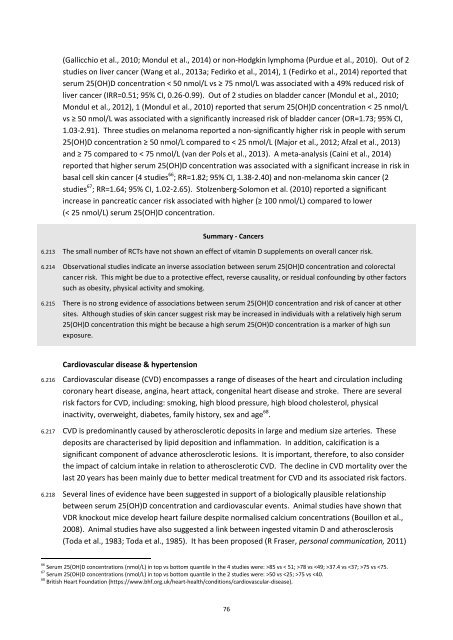Vitamin D and Health
SACN_Vitamin_D_and_Health_report
SACN_Vitamin_D_and_Health_report
Create successful ePaper yourself
Turn your PDF publications into a flip-book with our unique Google optimized e-Paper software.
(Gallicchio et al., 2010; Mondul et al., 2014) or non-Hodgkin lymphoma (Purdue et al., 2010). Out of 2<br />
studies on liver cancer (Wang et al., 2013a; Fedirko et al., 2014), 1 (Fedirko et al., 2014) reported that<br />
serum 25(OH)D concentration < 50 nmol/L vs ≥ 75 nmol/L was associated with a 49% reduced risk of<br />
liver cancer (IRR=0.51; 95% CI, 0.26-0.99). Out of 2 studies on bladder cancer (Mondul et al., 2010;<br />
Mondul et al., 2012), 1 (Mondul et al., 2010) reported that serum 25(OH)D concentration < 25 nmol/L<br />
vs ≥ 50 nmol/L was associated with a significantly increased risk of bladder cancer (OR=1.73; 95% CI,<br />
1.03-2.91). Three studies on melanoma reported a non-significantly higher risk in people with serum<br />
25(OH)D concentration ≥ 50 nmol/L compared to < 25 nmol/L (Major et al., 2012; Afzal et al., 2013)<br />
<strong>and</strong> ≥ 75 compared to < 75 nmol/L (van der Pols et al., 2013). A meta-analysis (Caini et al., 2014)<br />
reported that higher serum 25(OH)D concentration was associated with a significant increase in risk in<br />
basal cell skin cancer (4 studies 66 ; RR=1.82; 95% CI, 1.38-2.40) <strong>and</strong> non-melanoma skin cancer (2<br />
studies 67 ; RR=1.64; 95% CI, 1.02-2.65). Stolzenberg-Solomon et al. (2010) reported a significant<br />
increase in pancreatic cancer risk associated with higher (≥ 100 nmol/L) compared to lower<br />
(< 25 nmol/L) serum 25(OH)D concentration.<br />
Summary - Cancers<br />
6.213 The small number of RCTs have not shown an effect of vitamin D supplements on overall cancer risk.<br />
6.214 Observational studies indicate an inverse association between serum 25(OH)D concentration <strong>and</strong> colorectal<br />
cancer risk. This might be due to a protective effect, reverse causality, or residual confounding by other factors<br />
such as obesity, physical activity <strong>and</strong> smoking.<br />
6.215 There is no strong evidence of associations between serum 25(OH)D concentration <strong>and</strong> risk of cancer at other<br />
sites. Although studies of skin cancer suggest risk may be increased in individuals with a relatively high serum<br />
25(OH)D concentration this might be because a high serum 25(OH)D concentration is a marker of high sun<br />
exposure.<br />
Cardiovascular disease & hypertension<br />
6.216 Cardiovascular disease (CVD) encompasses a range of diseases of the heart <strong>and</strong> circulation including<br />
coronary heart disease, angina, heart attack, congenital heart disease <strong>and</strong> stroke. There are several<br />
risk factors for CVD, including: smoking, high blood pressure, high blood cholesterol, physical<br />
inactivity, overweight, diabetes, family history, sex <strong>and</strong> age 68 .<br />
6.217 CVD is predominantly caused by atherosclerotic deposits in large <strong>and</strong> medium size arteries. These<br />
deposits are characterised by lipid deposition <strong>and</strong> inflammation. In addition, calcification is a<br />
significant component of advance atherosclerotic lesions. It is important, therefore, to also consider<br />
the impact of calcium intake in relation to atherosclerotic CVD. The decline in CVD mortality over the<br />
last 20 years has been mainly due to better medical treatment for CVD <strong>and</strong> its associated risk factors.<br />
6.218 Several lines of evidence have been suggested in support of a biologically plausible relationship<br />
between serum 25(OH)D concentration <strong>and</strong> cardiovascular events. Animal studies have shown that<br />
VDR knockout mice develop heart failure despite normalised calcium concentrations (Bouillon et al.,<br />
2008). Animal studies have also suggested a link between ingested vitamin D <strong>and</strong> atherosclerosis<br />
(Toda et al., 1983; Toda et al., 1985). It has been proposed (R Fraser, personal communication, 2011)<br />
66 Serum 25(OH)D concentrations (nmol/L) in top vs bottom quantile in the 4 studies were: >85 vs < 51; >78 vs 37.4 vs 75 vs 50 vs 75 vs


